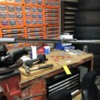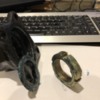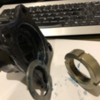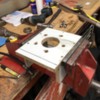Panteras by Wilkinson for the washer.
The axle nuts are a cinch nut that should bind, in fact this is where many who use new nuts fail to tighten down enough as they think it's tight, but it's not. I always use a high torque air impact wrench, you can actually hear the change in sound as the nut gets to it's final tightness.
I kept the washer 17 to have a good support on the part 16 and to be sure that the nut does not come to lock on the end of the thread on the axis, but compresses all the stacking well.
No, first of all because I didn't know them, but it's still a friction braking system, whereas with the toothed washer it is a positive lock.
Shaft grooving should normally be done on a milling machine, but since I had not done it with a grinder and the result is very acceptable.
Thanks all - Just a note to forestg - after going through the ordering system by the catalog on the Wilkinson I realized the car had been missing both the back and front bearing covers in both the half shaft assembly and a wide variety of plainly non essential obits and pieces.
Could explain the somewhat gritty nature of the bearings when I dissembled them....! Well worth while!
Bear in mind the stock axle washer has a rounded lower surface to match the curved inset on the mating halfshaft hub. Putting the washer in upside down will soak up part of the axle nut torque by bending things without contributing to assembly tightness. The shop manual torque is too low. No need for tricky nuts- the desired torque on that axle spanner-nut is 350-400 ft-lbs. Properly torqued, they survived LeMans & other contests just fine. Do not worry about stripping the threads- the SAE says that a 1-1/2" fine thread like this in mild steel strips at around 1200 ft-lbs! And please- do NOT use red Lock-tite. Poor guys like me have had to remove such nuts with a cutting torch after breaking a factory socket.
Leaving the axle nut washer off effectively lengthens the axle so the splined hub may bottom on the axle splines before things ever contact each other. So the parts will normally be sloppy-loose even at full torque. Both Wilkinson & Larry at PanteraParts.com in NV have new repro nuts & washers in stock, cheap. Good luck.
Thanks bosswench -dont worry I have ordered all of those "non essential" bits from Wilkinsons! May have explained why one nut was virtually finger tight when I took it off.... Also some very nice bluing on the bearing spacer
I have a full blown 500ft lb 1 ' drive torque wrench ( a hand me down from my dear old Dad who was a master mechanic with Ford for many years. ) so the tensioning should not be an issue.
If I had him here I would driving down the road by now! it will be a red letter day when this thing starts up again - 29 years now and counting !
Hold just reread the tread and Bosswrench says no - so sorry - no Locktight for this black duck. It going in dry.
And have new axle washers and have checked - in the right way.
Off to do the business.
Fantastic you have posted JFB . On your picture I notice 17 and 16 are faced together with the chamfer facing to the inside of the assembly. In addition 18 the lock not is shown as having it shoulder outwards. The shoulder on the nut appears to be designed to match the upper part of the inner washer to provide a precise contact area.
- I am just going to get a picture to explain it better.
Here is the orientation these were installed on disassembly . face chamfer on the washer outwards- you are showing it inwards , and bosswench says it should also be inwards. the nut had the ridge on the inside - looking at the drawing the ridge should be outwards
Attachments
the chamferred outer edge on the NUT is for the pre raised tabs on the locking washer.

since the pantera configuration does not use a lock washer, not really that critical.
HOWEVER, I would go with the norm orientation of the NUT champer against the washer. Possibly the nut's "Flat" outer face will provide a more positive engagement of the socket wrench
Attachments
Thanks JFB and Bosswrench . Ok - have gone with the axle washer rounded lower surface matching the curved inset on the mating half shaft hub and the raised face of the nut facing to the inside of the assembly mating to the flat back of the axle washer. It seems to make the most sense and it pulled up well. I pulled them down to 350 Ft/lbs.
I don't think they are coming loose anytime soon. Workbench is pretty solid but it started to move a bit - ML63 became a handy bench backstop!
Also attached a picture of the vice mounting jig I made up for the hub. It is heavy high density fiber board around 22mm thick and it had no issue with the loads. And it is pretty kind on the wheel studs.
Attachments
For the sake of the record at 350 ft /lbs starting from hard snug position, initially pulled up firmly with a 3/4" ratchet drive , then tensioned with a 1" drive tension wrench pulled to 350 ft /lbs tension , the nuts moved from hard snug by a full 1/4 turn of the nut +1/4 " to the final tensioned position .
All surfaces super clean , a little smear of bearing grease. If you could not obtain a tension wrench it would turn out pretty close.
This is consistent with structural friction joint bolting method on high strength bolts. FWIW.
FWIW, the more desirable full-height axle nuts (both left and right hand threads) may be partially split horizontally. This allows the upper and lower parts of the nut to distort slightly in one or more planes during tightening, so as to provide an integral locking function. Whether this distortion returns perfectly upon nut removal is not known. If not, re-use of the nut may mean much higher run-on torque and a lower holding power than what the nut originally delivered for a given torque. In spite of their cost, the safe move is to not reuse such nuts. I don't know what SAE grade any of the available nuts are, either. A pure guess is gr-5.
@Percy posted:F,,,the nuts moved from hard snug by a full 1/4 turn of the nut +1/4 " to the final tensioned position .
This is consistent with structural friction joint bolting method on high strength bolts. FWIW.
Thanks, good to know
did you notice what the thread pitch of the nut.
for the heavy equipment i use to work, Torque was very rarely used (only for the small stuff <1")
"Turn of the nut" was the most used method with actual bolt strain measurement being the preferred. as BossWrench just noted, too many things effect "torque"
Just thinking, for this assembly the amount of bolt "strain" probally is less than the inner /outer bearing spacer compression.
Oh, you said 1/4 turn, what is the 1/4" meaning? (is it, you went 1/4" on the outer diameter past 90 degrees?)
1/4 of the circumference of the nut + about 1/4" at the circumference more. That is it was consistently just a fleas dick over a quarter turn. If you did not have a LH tension wrench this would likely do the job and get you well over 300 Ft/lbs.
I did a google to find a conversion factor between the minimun measurable unit I was familiar with, RCH (red pubic hair) and your use of "flea dick". Unfortunately I did not get an answer and shockingly, I learned the phrase "Hung like a horse" does not do a flea justice!
SO I will assume a flea dick is several times greater than a RCH, but still a small amount ![]()
There is always confusion about such conversions. To really understand them one has to look into the origins of the two measurements. RCH (red pubic hair) originates back to intercourse between the British Screw Association (BA) and British Standard Pipe (BP) that declared several such measurement units . RCH (red pubic hair) was used for all visible measurements and the ubiquitous SMH ( Short mickey hair) for much finer tolerances.
The fleas dick unit , as you would know , was conceived by Dick Whitington, the inventor of the Whitworth system as an attempt to provide a standard that could be easily checked anywhere in the world by the use of the standard flea.
Less well known , the inclination angle of the appendage, was was in fact the basis of the 55 degree thread angle still with us today on our beloved Whitworth fasteners , and copied on by all proper fixings such as Brass Threads, British Standard Conduit (BSCon), Model Engineers (ME), and British Standard Copper (BSCopper).
Both terms , unfortunately , have defied all attempts at direct conversion into metric, although there was a rumor that a conversion table had been prepared by the French Meccano company based on MHS ( Milli Hair Standard.)
It lost something in the translation and never took off.









